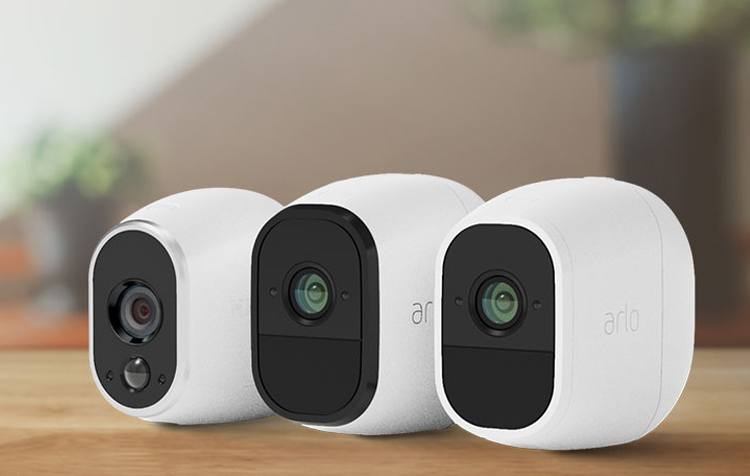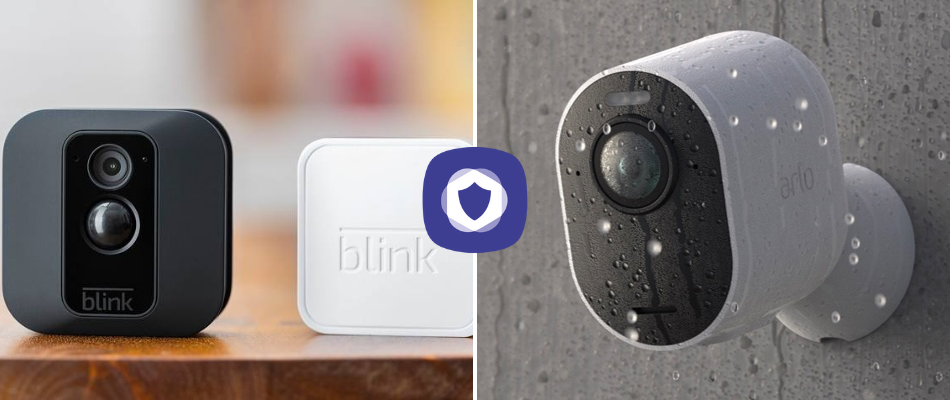If you’re looking for affordable home security cameras that provide crisp images, both Arlo and Blink are solid choices to consider.
Launched in 2016 as a Kickstarter project, Blink has quickly established a name for itself as a go-to in the home security space. It’s known for low-priced cameras that are super simple to set up. In late 2017, the company, which is headquartered in Andover, Mass., was acquired by Amazon.
Arlo Technologies, which is headquartered in San Jose, Calif., has been around a little longer. The company, which was founded in 2014, was originally a division of Netgear. It separated from Netgear in 2018.
Both companies offer attractive options for both indoor and outdoor cameras—Blink XT vs. Arlo Pro is a common comparison people make—but we think Arlo comes out ahead. Arlo offers more choices for both camera systems and storage options. Here is a deeper dive into what each company offers to help you decide for yourself which one may be right for your home.
Blink and Arlo: What do they have in common?
- Ease of use: Arlo and Blink cameras are both easy to install and get up and running. Neither offers professional installation service, but most customers report that they’re simple enough to DIY quickly.
- Quality images: Both companies are known for providing high-quality images. They both offer HD-quality video and night vision features.
- Affordability: Both Blink and Arlo offer affordable camera options, though Blink’s are the more affordable of the two. Both offer discounts when you purchase multiple cameras at a time.
- Self-monitoring only: Neither Blink nor Arlo offers professional monitoring. You have to be willing to take on monitoring yourself if you choose to use either of these cameras.
- No contracts: You don’t have to sign a contract to use Blink or Arlo. You pay for the cameras upfront, and the only additional expense is for an optional upgraded storage plan. Just note - these are not full security systems.
Blink and Arlo: What are the differences?
- Storage plan options: Most Blink cameras offer 7,200 seconds (2 hours) of video storage free, and there are no options to purchase additional storage for them. The only paid storage plans are for the new Blink Mini camera, which requires one. As of date of publication, all Blink Mini customers get a free trial subscription plan that runs through December 31, 2020. After that, the basic plan, which allows 60 days of rolling storage and covers one camera, costs $3/month or $30/year, and their Plus plan costs $10/month or $100/year for coverage of all the cameras you own.
- Extras: Arlo offers a variety of plans starting at $2.99/month that allow users get more cloud storage, and some offer the ability to dial 911 directly from the app if there’s an emergency.
- Variety of camera options: Blink offers just three cameras to choose from. If those meet your needs, great. If, however, you want more options to choose from, then Arlo is your company, as it offers an array of indoor and outdoor camera options, including wireless models and those that you plug into an electrical outlet.
Blink: What you need to know
Blink’s affordable cameras are good for those who want to install and monitor their cameras themselves. There are some pros and cons to consider before choosing this company, however.
Pros
- Affordable: With the new Blink Mini camera ringing it at just $34.99, Blink is no doubt an affordable way for people to increase the security of their homes.
- High-quality video: Image quality is excellent. Blink cameras feature HD quality footage day and night.
- Long battery life: Blink cameras come with a rechargeable battery that’s designed to last up to two years.
Cons
- Limited storage options: With Blink’s two main cameras—the Blink XT2 indoor/outdoor security camera and the Blink Indoor—there is no option for additional storage beyond the free two hours. The new Blink Mini, however, requires one of two subscription storage plans in order to store footage: The Basic plan, which runs $3/month or $30/year and the Plus plan, which runs $10/month or $100/year. Both offer 60 days of rolling video storage, while the Basic plan supports one Mini camera, the Plus plan supports an unlimited number of Minii cameras. The site also states that local storage for the Blink Mini is coming soon.
- Few equipment choices: While the recent addition of the Blink Mini camera is welcome, Blink still doesn’t offer as many equipment options as other security camera companies.
- No professional monitoring option: Blink offers no professional monitoring options. All monitoring is the responsibility of the buyer, so you have to be up for the job.
Arlo: What you need to know

Arlo also offers affordable options for those who are willing to install and monitor their cameras themselves. It offers a variety of models and storage plans that make it a great choice, but there are some cons to consider as well.
Pros
- High-quality images: Arlo cameras, such as the Arlo Pro and Arlo Ultra, feature HD video and night vision (some even feature color night vision), so you can see what’s happening in and around your home day and night.
- 911 emergency feature: Some Arlo storage plans allow you to dial 911 directly through the app if you see anything suspicious on the camera feed.
- Storage plan options: You can store up to seven days of footage for free, but if you want to save more in their cloud storage, Arlo offers several plans that also include additional smart features. Both the Premier and Elite plan provide up to 30 days of storage, motion detection in selected zones, more advanced alerts and the 911 emergency feature. The Elite plans offer higher resolution video quality (4k video resolution as opposed to the Premier plan’s 2k) and costs $4.99/month per camera or $14.99/month for up to five cameras. The Premier plan costs $2.99/month per camera or $9.99/month for up to five cameras.
- Array of product offerings: Arlo offers numerous choices when it comes to home security products. They include indoor and outdoor cameras, a baby monitor, doorbells, security lights and more.
Cons
- No professional monitoring: Arlo doesn’t offer any professional monitoring options. While self monitoring is less expensive than professional monitoring, it doesn’t offer the same reassurance as knowing that trained professionals are available 24/7 should an emergency arise.
- Mediocre battery life: You will likely find yourself having to change the batteries in Arlo cameras more frequently than you would with some of their competitors, including Blink.
Blink or Arlo?
Between these two, we pick Arlo because it offers more flexibility in choosing camera models and storage plan options. But both Arlo and Blink are good choices for people who want to add security cameras to their home and don’t mind installing and monitoring them by themselves. They’re also both good choices if you don’t want to commit, as neither requires signing a contract. If you want more choices and want to store video for longer periods of time, then Arlo is your best bet, but you can’t go wrong with either company.
Still debating?
We have in-depth reviews of both Blink and Arlo cameras.
Made your call?
As an Amazon Associate we earn from qualifying purchases. Participation in these programs helps us keep the site up, and to continue to help you find great products. Our editorial process is in no way impacted by partnerships.
This article has been reviewed and approved by Officer Banta.

Officer Banta is the official SecurityNerd home security and safety expert. A member of the Biloxi Police Department for over 24 years, Officer Banta reviews all articles before lending his stamp of approval. Click here for more information on Officer Banta and the rest of our team.

